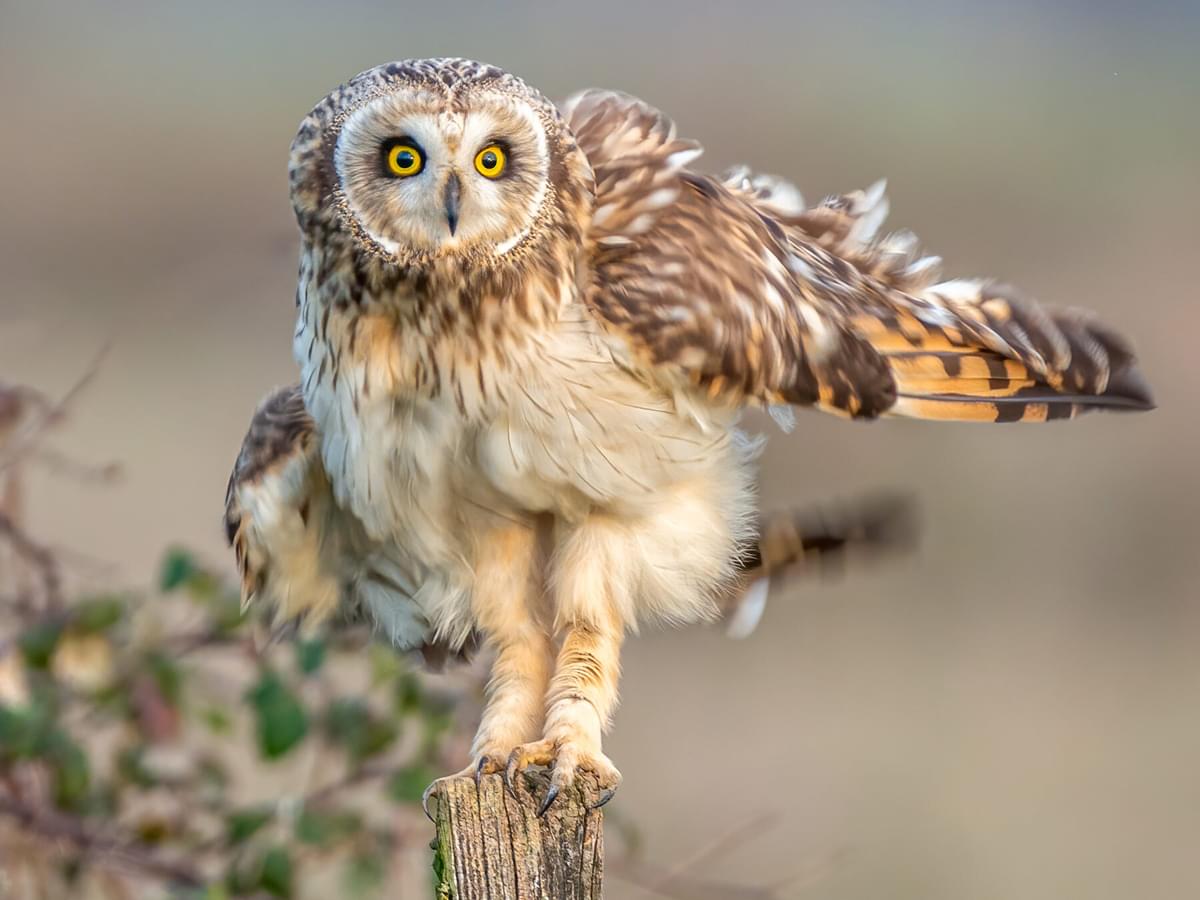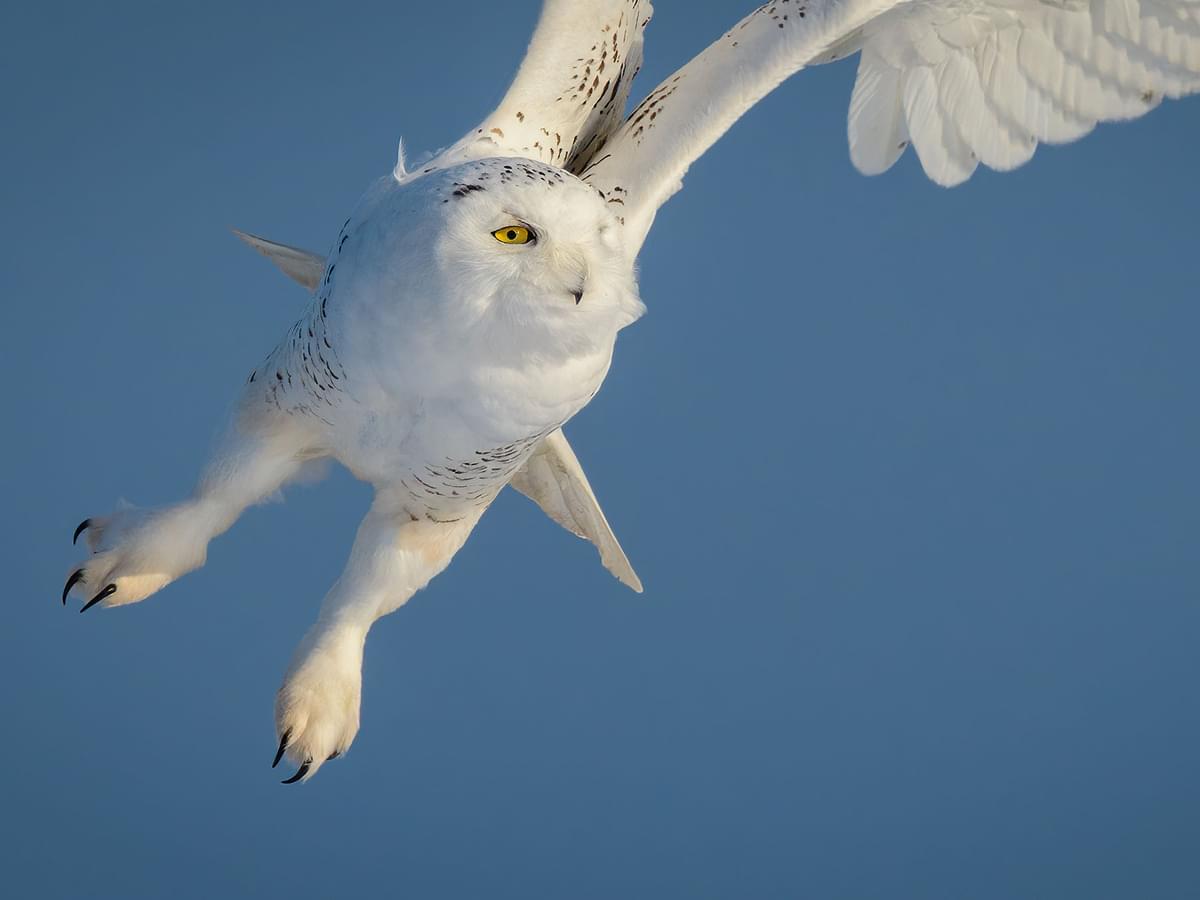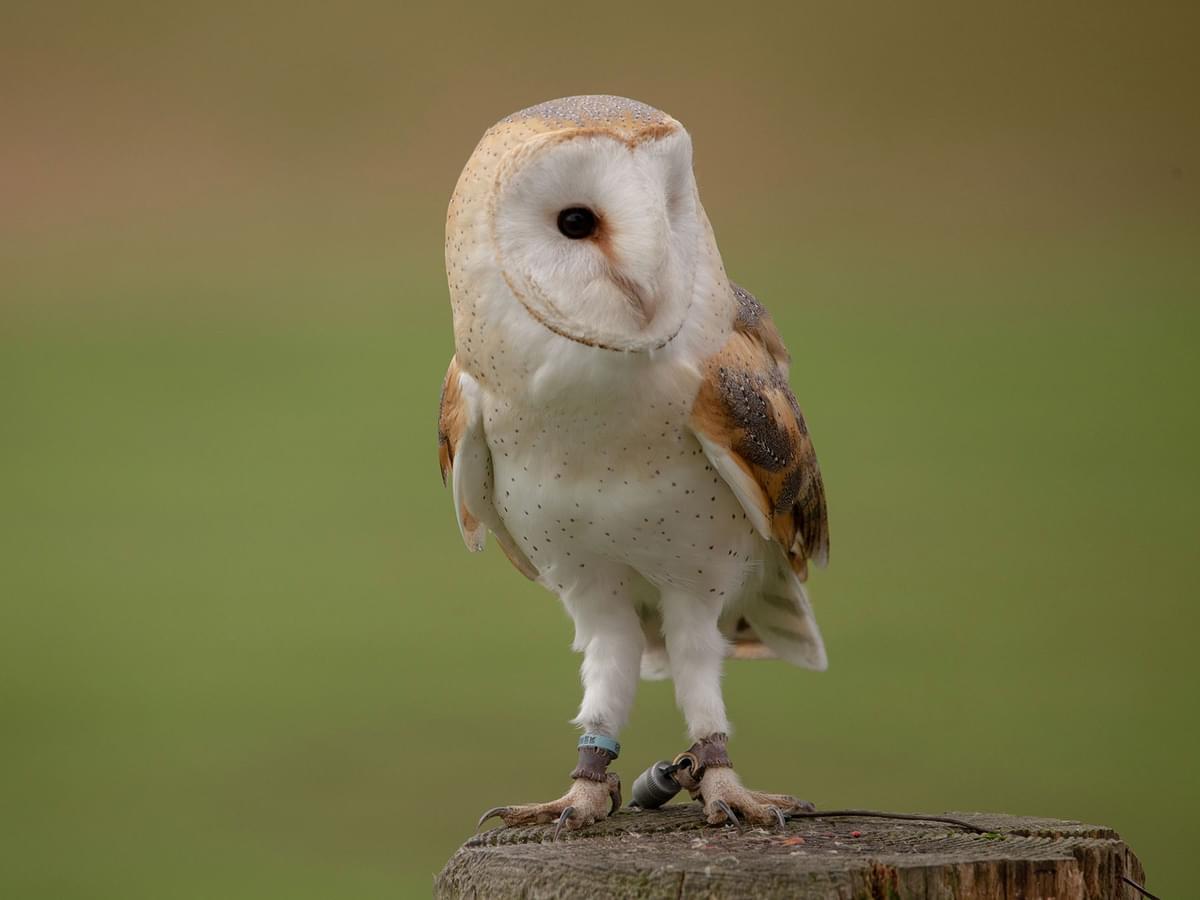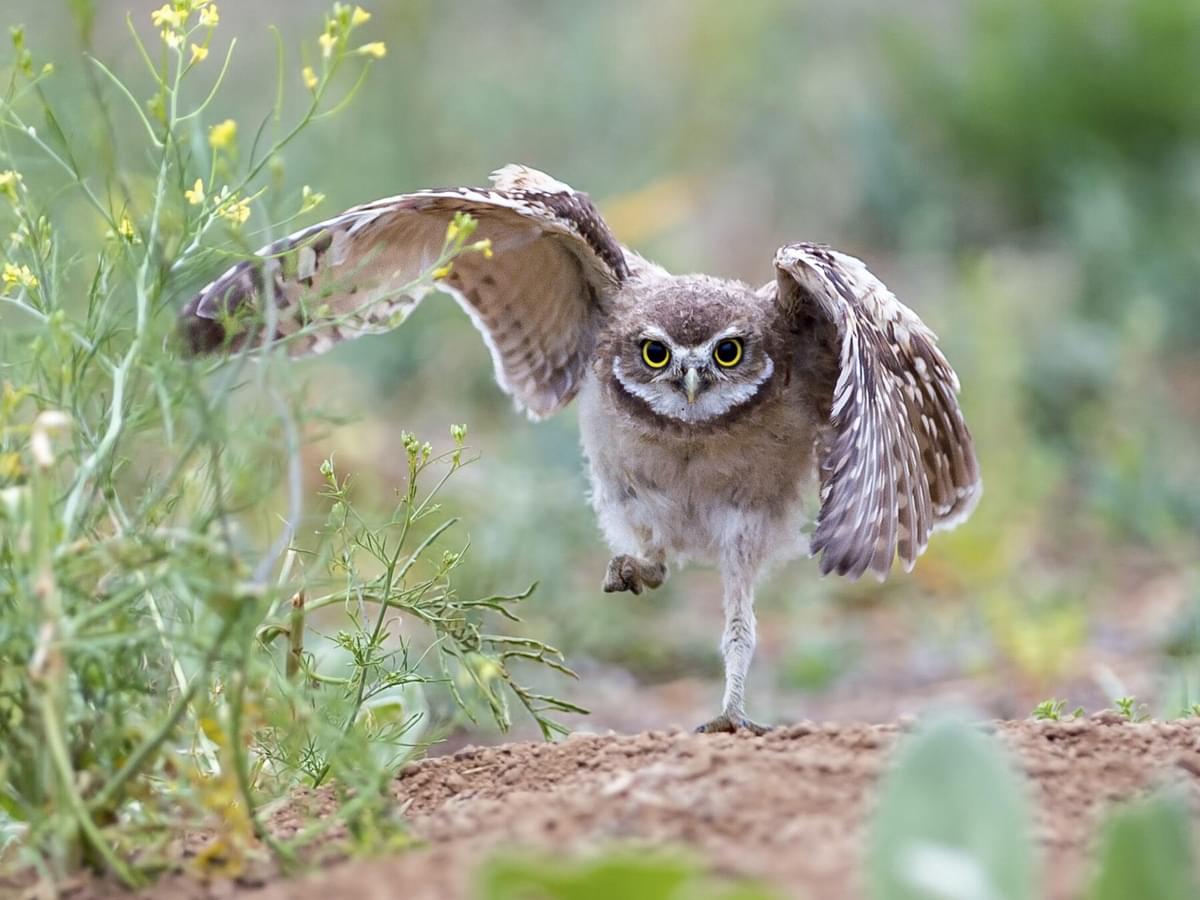When you think about an owl’s appearance, it’s likely that the first standout feature that comes to mind isn’t its legs, but rather its piercing eyes, round face and sharp, curved talons.
Owls’ legs are perhaps one of their least seen and most mysterious features, usually remaining hidden out of sight by a layer of thick downy feathers.
Numerous comical viral photos have been posted online of owls in bandy-legged poses, revealing just how long their legs are beneath all the fluffiness.
We’ll be taking an in-depth look at the anatomy of an owl’s legs and the role they play in owl flight, hunting techniques and temperature regulation.

The long legs of a Short-eared Owl
Anatomy of Owl Legs
The physical anatomy of an owl’s legs includes several familiar components: a femur, a knee, a tibia and fibula, an ankle, a foot and four toes. Despite their legs being fairly long, thin and in some cases appearing to be spindly, they are far from delicate or ineffective. Their talons are notoriously effective at piercing prey and gripping it from both sides.
Owls have relatively short thigh bones, with knees that are relatively high up on their legs. The leg joint that is usually most visible is in fact the ankle. Long shin bones and powerful thigh muscles work together, enabling more flexible and controlled movements.
Feather covering
The dense layer of feathering on an owl’s legs and feet is believed to serve multiple purposes. Not only offering protection against cold weather and insulation when temperatures drop, the thick down also provides an extra layer of defense against being bitten by prey while they are hunting.

The feather covering of a Snowy Owl's legs
Talons
Owls have four talons: two are forward-facing, one is rear-facing and the fourth has a flexible joint that allows it to rotate, similar to a human’s thumb. In flight and sometimes when perched, the fourth, outer talon is moved into a forward-facing position, with just one rear-facing toe.
When gripping onto prey, this talon rotates, offering a stronger, wider and more controlled hold. When going in for the kill, talons are spread wide to maximize the chance of a successful catch.

Close up of an Eagle Owl's Talons on show in flight
Length
Among the more than 200 owl species in the world, there is significant variation on the length of legs and whether or not they are covered in fine down, thick feathers or are completely bare.
Owls that are native to savannas and prairies of Africa, Australia and Asia hunt in longer grasses and have adapted to have longer legs so as to be able to catch prey effectively from the taller vegetation.
Snowy owls’ and eagle owls’ legs are covered in the thickest down to aid with preventing heat loss in sub-zero temperatures. Barn owls’ legs are also comparatively long, but are not densely covered in down, which allows them to hunt in wet grasslands without becoming waterlogged.
Similarly, fish owls have legs that are free from feathers and down, so they can catch prey from rivers and lakes without being weighed down by excess water.

Barn Owl perched on a post, showing legs
Adaptive Advantages
Silent Hunting
Owls are silent hunters and are able to glide undetected in pursuit of prey, and their long, powerful and feathered legs are an important factor in achieving soundless flight. The downy covering of their legs has a muffling effect that minimizes sound by absorbing excess noise and reduces turbulence, breaking up the flow of air around their bodies as they fly.
Their strong leg muscles allow them to grip prey securely without the risk of dropping it. This control and stability results in smoother flight, which in turn creates less noise as they move through the air.
Perching and Gripping
Like those of many birds of prey, the feet of an owl feature a locking mechanism that latches the curved talons around a branch or perch without the need for the muscles to remain constantly contracted in the gripping position.
Owls are particularly dextrous, thanks to their flexible talons that are able to move independently of each other. This helps to adjust the grip on their prey (or on their perch) as needed, without losing any of the power in their hold.
They have a unique arrangement of talons, with two facing forwards, one backwards and one that is able to change position according to need, offering a secure and controlled grip, as well as better balance and improved stability.
Having long legs also brings benefits to owls when nesting, as they are able to maneuver around their nests on foot with ease, which enables them to remain extra vigilant and successful when raising young.
Thermoregulation
In some owl species, the soles of the feet help to regulate body temperature. Excess heat is radiated away from the body through the soles of the feet, which have extra blood vessels.
Owls with heavily feathered legs benefit from the layer of insulation around their bare skin, preventing an excessive level of heat loss.

Perched Western Screech-owl, looking rather suprised
Myths and Symbolism
Owls are frequently associated with wisdom, and some interpretations extend to viewing their legs as the foundation of their deep knowledge. An owl’s elongated legs may be interpreted to represent adaptability and versatility in acquiring this wisdom.
Another key symbolic meaning of owls’ legs relates to grounding oneself and trusting in your inner intuition and guidance to follow the right path and make the right choices in life.
Owls’ legs help them to hunt with stealth and precision, and in some cultures, this is viewed as a symbol of flexibility and adapting well to different circumstances, particularly those that are unexpected.

Eagle Owl striking prey with long legs
Owl Legs in Flight
In flight, an owl positions its legs in a particular way to generate more effective aerodynamics as it moves through the air.
- Legs are folded close to the body and tucked under feathers.
- Feet face forwards which enables them to land steadily and grasp prey without any additional maneuvering.
In flight, an owl’s legs are centralized, balancing their body weight and enabling stable and streamlined flight.

Short-eared owl in flight, with legs tucked close to the body
Owl Legs: A Comparison
Birds of prey rely on strong, powerful talons as a key hunting tool, and like owls, they benefit from having a zygodactyl arrangement of toes on their feet, with two forward-facing toes and two that face backwards, allowing a secure grip on prey and when perching.
Owls usually have longer legs compared to their body size than hawks, eagles and falcons. Raptors legs are also usually bare, rather than covered in dense feathering and down. Exceptions are the rough-legged hawk, the ferruginous hawk and the golden eagle, which have thick feathers that extend down to their toes.
Not all owls’ legs are the same, with considerable variation existing depending on habitat and hunting techniques.
- Owls that live in grasslands and low-lying terrain have adapted to have longer legs, to enable more effective hunting pursuit on the ground.
- Snowy owls have legs that are covered in dense feathering, which provide valuable insulation in frozen landscapes.
- Owls that inhabit wetlands usually have bare legs, or legs that are covered in a powder-fine water-repellent down, which helps them avoid becoming waterlogged when hunting.

Young Barred Owl stood up on a branch, with visible legs
Conservation Aspects
Loss of habitat, in particular grasslands and prairie habitats, is a real concern to the future survival of certain owl species that have evolved as effective hunters on foot, striding through grassy plains in pursuit of prey and living in ground-level burrows.
Fragmentation of habitats may result in owls being left less able to hunt effectively.
Another threat to owls, directly related to their legs, is illegal wildlife trade. Owls’ feet are particularly sought after in some cultures as talismans or for use in traditional medicines.
Illegal trapping can impact owl populations and legislation banning the sale of animal parts should be enforced globally.
Summary
Owls rely on their long legs for increased mobility, more effective hunting and improved nesting success. Feathered legs offer camouflage and protection when hunting, and play a valuable role in body temperature regulation for owls living in colder climates.
Knowing more about the leg structure hidden beneath the thick downy feathers of owls will certainly give you yet another reason to be in awe of these graceful silent hunters and the precision with which they catch prey.

Burrowing Owl running on the ground
FAQs
Are owl legs long or short?
Many owl species have surprisingly long legs, which are typically covered in feathers or thick down. An owl’s legs can measure up to half the total height of its body, but in most species only the feet and lower legs are usually visible.
What is the function of feather-covered legs in owls?
A dense covering of feathers serves three key purposes on the legs of owls: defense from the cold, protection from being bitten by prey when hunting and camouflage against their habitats.
A thick layer of down acts as insulation for owls living in colder climates, preventing body heat from being lost through bare skin on their legs. Also, this fluffy layer of feathers provides an ideal barrier against the sharp teeth or claws of prey that might attempt to fight back when caught.
How do owls use their legs for hunting?
Owls’ legs are powerful and strong, allowing them to grip and carry large prey items without fear of dropping them. Their thigh muscles work with their curved talons to hold onto prey effectively both when hunting and in flight, while the arrangement of their toes aids with perching for long periods while stalking prey.
Some owls pursue their prey on foot, including burrowing owls and grass owls. Great horned owls may stealthily stalk prey on foot or wade into a shallow pond before plunging to catch fish or frogs.

Long-eared Owl hunting an unsuspecting mouse at night
Are there any unique features in the legs of different owl species?
Most owls have similar legs: relatively long, and usually covered in feathers or down. However, there is variation between species.
For example, owls native to colder climates, including snowy owls and eagle owls, have thicker down on their legs than owls native to tropical regions. Owls that hunt in grasslands have longer, less densely feathered legs, allowing them to stalk prey on foot through areas of tall grass.
Barn owls have a serrated, comb-like surface on the underside of their middle talon, which aids with preening and grip.
Why do owls have long legs?
Owls have evolved with long legs for multiple purposes, including more streamlined, silent flight, a strong powerful grip on different-sized prey, and the ability to stalk prey on foot in particular habitats. Owls stretch out their legs when hunting, allowing them to grab prey seamlessly after swooping down on their target.
What owl has the longest legs?
In terms of total length, it’s fairly safe to assume that the Eurasian eagle owl has the longest legs of all owl species, measuring between 20 cm and 38 cm. As the tallest owls, reaching a maximum height of around 75 cm (30 in), their legs can account for up to half of their height.
What do you call an owl's legs?
There’s no special scientific term for an owl’s legs – they’re simply known as legs!

The Eurasian Eagle Owl has the longest legs of any owl
Do owls have knees?
Owls do have knee joints with fully functioning kneecaps, although their knees are rarely on display, hidden by the dense down or feathers of their upper legs.
Often an owl’s ankles – which are located above their feet and are more often visible – might be mistaken for knees.
Owls have the same physical anatomy in their legs as humans, with thighs, knees, shins, ankles, feet and toes, but these components differ in proportion to the corresponding bones in a human skeleton.
Do owls walk?
Owls can walk, hop and run, but most are rarely seen moving on the ground unless they’re injured or in poor health. Walking on the ground leaves them vulnerable to predators, and where possible, they avoid spending long periods close to the floor. They can be observed stepping along branches while perching too.
Can owls run?
The most famous example of an owl that runs is the burrowing owl, which has evolved to hunt mainly on foot, scurrying in fast pursuit of prey across the grasslands of North and South America. Usually seen with their wings spread out to help them balance as they sprint, burrowing owls can reach running speeds of up to around 25 mph.
Can owls walk backwards?
Owls are able to walk in any direction, including in reverse and sideways, due to their specially adapted talon structure of two toes facing forwards, one facing backwards and one that can rotate, which enables them to step backwards.
